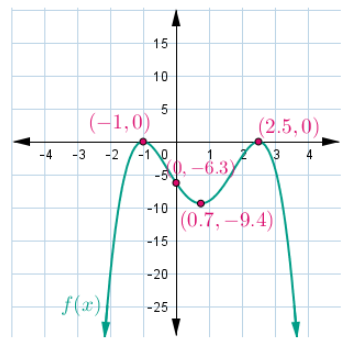Consider the graph of f(x). -4 الله (-1,0) -2 -1 15 10 5 --5-6.3) -10 -15 -20 -25 (2.5,0) 3 4 (0.7,-9.4) Ⓒ2020 StrongMind. Created using GeoGebra. Which statements are true about the function represented by the graph? Select all that apply. The function has two relative maxima, both 0, and a relative minimum of -9.4. The function increases over the intervals (-1,0.7) and (2.5, ∞), and it decreases over the intervals (-∞, -1) and (0.7, 2.5). The function has two relative maxima of -1 and 2.5, and a relative minimum of 0.7. The function increases over the intervals (-∞, -1) and (0.7, 2.5), and it decreases over the intervals (-1,0.7) and (2.5, ∞0). As a approaches negative infinity, f(x) approaches negative infinity, and as a approaches infinity, f(x) approaches negative infinity. As a approaches negative infinity, f(x) approaches negative infinity, and as a approaches infinity, f(x) approaches infinity.
Consider the graph of f(x). -4 الله (-1,0) -2 -1 15 10 5 --5-6.3) -10 -15 -20 -25 (2.5,0) 3 4 (0.7,-9.4) Ⓒ2020 StrongMind. Created using GeoGebra. Which statements are true about the function represented by the graph? Select all that apply. The function has two relative maxima, both 0, and a relative minimum of -9.4. The function increases over the intervals (-1,0.7) and (2.5, ∞), and it decreases over the intervals (-∞, -1) and (0.7, 2.5). The function has two relative maxima of -1 and 2.5, and a relative minimum of 0.7. The function increases over the intervals (-∞, -1) and (0.7, 2.5), and it decreases over the intervals (-1,0.7) and (2.5, ∞0). As a approaches negative infinity, f(x) approaches negative infinity, and as a approaches infinity, f(x) approaches negative infinity. As a approaches negative infinity, f(x) approaches negative infinity, and as a approaches infinity, f(x) approaches infinity.
Algebra for College Students
10th Edition
ISBN:9781285195780
Author:Jerome E. Kaufmann, Karen L. Schwitters
Publisher:Jerome E. Kaufmann, Karen L. Schwitters
Chapter8: Functions
Section8.4: More Quadratic Functions And Applications
Problem 59PS
Related questions
Question

Transcribed Image Text:Consider the graph of f(x).
15
10
5
(-1,0)
(2.5,0)
-4 -3 -2 -10
4
-P₂
ħ
-10 (0.7,-9.4)
-15
-20
-25
© 2020 StrongMind. Created using GeoGebra.
Which statements are true about the function represented by the graph?
Select all that apply.
The function has two relative maxima, both 0, and a relative minimum of -9.4.
The function increases over the intervals (-1,0.7) and (2.5, ∞), and it decreases over the intervals (-∞, -1) and (0.7, 2.5).
The function has two relative maxima of -1 and 2.5, and a relative minimum of 0.7.
The function increases over the intervals (-∞, -1) and (0.7, 2.5), and it decreases over the intervals (-1,0.7) and (2.5, ∞).
As a approaches negative infinity, f(x) approaches negative infinity, and as a approaches infinity, f(x) approaches negative infinity.
As a approaches negative infinity, f(x) approaches negative infinity, and as a approaches infinity, f(x) approaches infinity.
Expert Solution
Step 1
Given

Step by step
Solved in 2 steps with 1 images

Recommended textbooks for you

Algebra for College Students
Algebra
ISBN:
9781285195780
Author:
Jerome E. Kaufmann, Karen L. Schwitters
Publisher:
Cengage Learning

Algebra & Trigonometry with Analytic Geometry
Algebra
ISBN:
9781133382119
Author:
Swokowski
Publisher:
Cengage


Algebra for College Students
Algebra
ISBN:
9781285195780
Author:
Jerome E. Kaufmann, Karen L. Schwitters
Publisher:
Cengage Learning

Algebra & Trigonometry with Analytic Geometry
Algebra
ISBN:
9781133382119
Author:
Swokowski
Publisher:
Cengage


Glencoe Algebra 1, Student Edition, 9780079039897…
Algebra
ISBN:
9780079039897
Author:
Carter
Publisher:
McGraw Hill

Algebra: Structure And Method, Book 1
Algebra
ISBN:
9780395977224
Author:
Richard G. Brown, Mary P. Dolciani, Robert H. Sorgenfrey, William L. Cole
Publisher:
McDougal Littell
